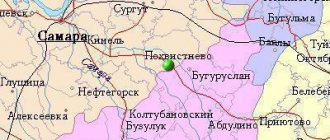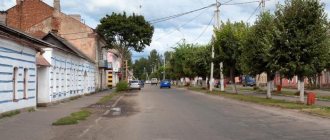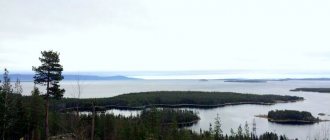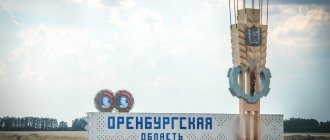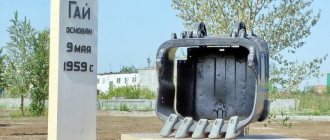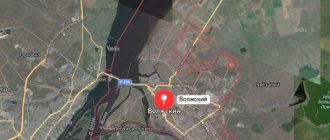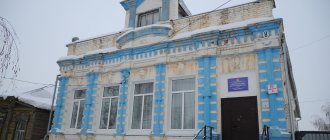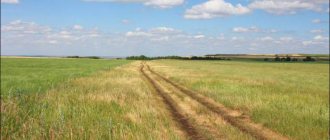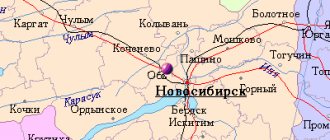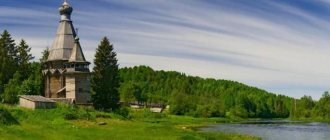The city of Abdulino is located on the Tiris River, 280 km northwest of Orenburg. Named after the eldest of all the settlers, Abdulla Yakupov, a Tatar from the Simbirsk governorship. The first mention of Abdulino dates back to 1795. Then, according to the census of the empire, the “newly established” village of Abdulov was recorded. The village was inhabited by shepherds and herders, a total of 37 people. Since 1811 it began to be called Abdulino.
A large influx of population to these places was caused by the construction of the Samara-Ufa railway. Abdulino found himself at the intersection of a steel highway with the ancient horse-drawn road Orenburg-Bugulma-Kazan. The advantage of this location accelerated the development of industry in the village. On September 8, 1888, the first train passed here along the newly completed railway line from Kinel station to the Safronovskaya pier on the Belaya River near the city of Ufa. At the same time, a locomotive depot, a station, and later workshops for repairing railway equipment were built in Abdulino.
Already in 1895, she built a plant beyond the Tiris River for processing buckwheat into cereal. A large steam mill and elevator were built in Abdulino. Shops, warehouses, and procurement offices appeared like mushrooms after a warm rain.
In 1923, Abdulino received city status. On November 19, 1923, the All-Russian Central Executive Committee awarded the Order of the Red Banner of Labor to the native Abdulino “machinist F.P. Kazantsev.” - for the invention of a new system of brakes that could completely replace the Westinghouse brakes. A street in Abdulino is named after the talented inventor-compatriot. There is a memorial plaque on the house where he lived.
In 1935, two enterprises were put into operation in Abdulino - a carriage depot and an oil-raw-casein factory, which in 1965 was transformed into a dairy plant.
During the Great Patriotic War, thousands of Abdullinites went to the front to defend their homeland. Many of them served in the 195th Infantry Division.
The Abdullin land raised ten Heroes of the Soviet Union. These are sailor Nikolai Golubkov, tankman Pavel Kopylov, artillerymen Mikhail Sorokin and Mingaz Khairutdinov, scouts Georgy Komarov and Mikhail Kelchin, cavalryman Alexey Vorontsov, infantrymen Alexey Konovalov, Nikolai Fomin, Pavel Pavlov. Three Abdullin residents - Semyon Bogoslovsky, Polikarp Anpilogov and Pyotr Kornilov became full holders of the Order of Glory.
In the post-war years, a new enterprise was opened in Abdulino - a mechanical plant.
The city is divided into two parts by the railway track (the railway station building, built in 1895, is an architectural monument). In one part there are all the administrative buildings, banks, large shops, the city market and the central telegraph, the city mosque and the Orthodox Church, and the local history museum. On the main street - preserved from the beginning of the 19th century. merchant development. The second part: the sector of one-story private houses. The head of the administration plans to restore the main street, its architectural appearance, and reunite the street with the park where the Alexander Nevsky Cathedral, built in 1913, once stood.
Sources
- “Guide to the Orenburg region. First edition” Printed at JSC IPO “Lev Tolstoy”, Tula. 2006
- V.G. Altov “Cities of the Orenburg Region”. Chelyabinsk, South Ural book. publishing house, 1974. 254 p. with ill.
Short review
The city is located among the most picturesque nature of the Urals. This location provides people with clean air and a favorable climate. For lovers of fishing and simply wild recreation, the Tiris water stream flows here (a tributary of the Ik River). Its waters are also used for other purposes, such as irrigation. The Orenburg region has long been famous for its beautiful landscapes, Abdulino is a city where the population as of January 2016 was about 19.3 thousand people.
Links[edit]
Notes[edit]
- ^ abcd Law No. 1370/276-IV-OZ
- ^ abc Federal State Statistics Service (2011). “All-Russian Population Census 2010. Volume 1" [All-Russian Population Census 2010, vol. 1]. All-Russian Population Census 2010 [All-Russian Population Census 2010]
. Federal State Statistics Service. - "26. The size of the permanent population of the Russian Federation by municipalities as of January 1, 2022". Federal State Statistics Service. Retrieved January 23, 2022.
- ^ ab State Committee of the Russian Federation on Statistics. Committee of the Russian Federation for Standardization, Metrology and Certification. No. OK 019-95 January 1, 1997 “All-Russian classifier of objects of administrative-territorial division. Code 53 203", ed. changes No. 278 / 2015 dated January 1, 2016. (Goskomstat of the Russian Federation. Committee of the Russian Federation for Standardization, Metrology and Certification. No. OK 019-95 January 1, 1997. Russian classification of administrative divisions) (OKATO).
Code 53 203 , as amended by Amendment No. 278/2015 of January 1, 2016). - ^ ab State Committee of the Russian Federation on Statistics. Committee of the Russian Federation for Standardization, Metrology and Certification. No. OK 019-95 January 1, 1997 “All-Russian classifier of objects of administrative-territorial division. Code 53 404", ed. changes No. 278 / 2015 dated January 1, 2016. (Goskomstat of the Russian Federation. Committee of the Russian Federation for Standardization, Metrology and Certification. No. OK 019-95 January 1, 1997. Russian classification of administrative divisions) (OKATO).
Code 53 404 , as amended by Amendment No. 278/2015 of 01/01/2016). - Law No. 2367/495-IV-OZ
- ^ ab Law No. 3240/876-V-OZ
- "On the Calculation of Time". Official Internet portal of legal information
. June 3, 2011. Retrieved January 19, 2022. - Post office. Information and computing center of OASU RPO. ( Post office
).
Search for postal service objects ( postal Search for objects
) (in Russian) - ↑
Federal State Statistics Service of Russia (May 21, 2004).
“The population of Russia, the constituent entities of the Russian Federation as part of federal districts, urban settlements, settlements, settlements is 3 thousand or more people” [Population of Russia, its federal districts, federal districts, districts Urban settlements, rural settlements - administrative centers and rural settlements with a population of over 3,000] (XLS). All-Russian Population Census 2002
. - “All-Union Population Census of 1989. The current population of union and autonomous republics, autonomous regions and districts, territories, negative phenomena, urban settlements and villages. All-Union Population Census of 1979. National composition of the population by regions of Russia” [All-Union Population Census of 1979. Ethnic composition of the population by regions of Russia] (XLS). All-Union Population Census of 1979 [All-Union Population Census of 1979]
.
1979 - via Demoscope Weekly
(website of the Institute of Demography of the State University - Higher School of Economics. - Resolution No. 4-p
Historical excursion
The first mention of this settlement was found in 1795. This is considered the date of birth of Abdulino. The village received its name in honor of its founder, the successful merchant Abdula Yakupov. For 100 years, this settlement was just a small village.
Like other corners of the Russian Federation, the Orenburg region captivates with its beauty. Abdulino was transformed from a rural settlement. After the construction of the railroad in 1811, business life in this city became noticeably livelier, which led to an increase in the local population. The legendary Orenburg highway, passing through the village (now the Kazan-Orenburg federal highway), also contributed greatly to prosperity. Since 1923, Abdulino turned into a city, then became a regional center.
Abdulino
(Orenburg region)
OKATO code:
53404
Founded:
1795
City since:
1923 City of regional subordination
Center:
Abdulinsky district
Telephone code (reference phone)
| 35355***** | 21-6-28 |
Deviation from Moscow time, hours:
2
Geographic latitude:
53°41′
Geographic longitude:
53°39′
Altitude above sea level, meters:
190 Sunrise and sunset times in the city of Abdulino
Economy
Transport connections play a big role in the development of cities and regions. The Orenburg region is also of considerable importance thanks to this industry. Abdulino has a railway station of the same name. Much of the city's business life is connected to the railroad. Moreover, this is not just a station, but an entire railway junction, which connects all the routes to the European part of our country and to the Urals. They come from the Far East, Siberia and Kazakhstan.
Therefore, one of the largest enterprises in our country for the repair of track machines and the production of spare parts is located here. By the way, this is also depicted on the city coat of arms: a gear is depicted on a red background, and inside it is a locomotive. Ears of grain can be seen on the city flag.
Livestock breeding and agriculture are the basis of the Abdulinsky district. However, these industries are developing well throughout the entire territory of this administrative center. The Orenburg region (Abdulino) is famous for the cultivation of many crops. There is also a plant for the production and repair of agricultural machinery.
Map
| Abdulino: maps |
Abdulino: photo from space (Google Maps) Abdulino: photo from space (Microsoft Virtual Earth)
| Abdulino. Nearest cities. Distances in km. on the map (in brackets along roads) + direction. Using the hyperlink in the distance , you can get the route (information courtesy of the AutoTransInfo website) | |||
| 1 | Matveevka | 22 (32) | SW |
| 2 | Priyutovo (Republic of Bashkortostan) | 30 (193) | NE |
| 3 | Bizhbulyak (Republic of Bashkortostan) | 40 (72) | IN |
| 4 | Ermekeyevo (Republic of Bashkortostan) | 44 (164) | WITH |
| 5 | Ponomarevka | 50 (58) | SE |
| 6 | Asekeevo | 56 (134) | Z |
| 7 | Belebey | 56 (180) | NE |
| 8 | Kirghiz-Miyaki (Republic of Bashkortostan) | 75 (269) | IN |
| 9 | Buguruslan | 81 (108) | Z |
| 10 | Serafimovsky (Republic of Bashkortostan) | 82 (112) | WITH |
| 11 | Bavly | 83 (81) | WITH |
| 12 | Northern | 86 (165) | NW |
| 13 | October | 89 (102) | WITH |
| 14 | Pleshanovo | 93 () | YU |
| 15 | Raevsky (Republic of Bashkortostan) | 94 (253) | NE |
| 16 | Subkhankulovo (Republic of Bashkortostan) | 98 (130) | WITH |
| 17 | Grachevka | 98 (263) | SW |
| 18 | Pokhvistnevo | 99 (127) | Z |
| 19 | Tuymazy | 101 (122) | WITH |
| 20 | Kandra (Republic of Bashkortostan) | 101 (149) | WITH |
| 21 | Urussu (Republic of Tatarstan) | 102 (118) | WITH |
| 22 | Davlekanovo | 108 (253) | NE |
| 23 | Kamyshla (Samara region) | 109 (185) | NW |
| 24 | Sterlibashevo (Republic of Bashkortostan) | 109 (249) | IN |
| 25 | Bugulma | 110 (119) | NW |
| 26 | Sharlyk | 110 (133) | SE |
| 27 | Buzdyak (Republic of Bashkortostan) | 113 (192) | NE |
| 28 | Fedorovka (Republic of Bashkortostan) | 117 (219) | SE |
a brief description of
The city is located in the Urals, on the river. Tiris (Surmet??) (tributary of the Ik River).
Railway node
Territory (sq. km): 1786
Information about the city of Abdulino on the Russian Wikipedia site
Historical sketch
Mentioned in a document of 1795 as the “newly established village of Abdulov”. Named in honor of elder Abdul Yakupov. Since 1811 Abdulino.
After the construction of the Samara-Zlatoust Railway in 1886-88, it became a railway junction. station, a significant center for grain processing and grain trading.
City since 1923.
Economy
A plant for the repair of track machines and the production of spare parts, a bakery plant, an experimental plant for the production of agricultural machines, etc.
In the Abdulinsky district, wheat, rye, barley, oats, buckwheat, peas, corn, potatoes, and beets are grown. They raise cattle, pigs, and horses.
Deposits of limestone, gypsum, ocher.
To the southeast of Abdulino, in the upper reaches of the Dema River, there is a group of oil and gas fields.
Main enterprises
TRACTOR AND AGRICULTURAL ENGINEERING
JSC "Abdulino Experimental Plant"
461760, Orenburg region, Abdulino, st.
Mira, 32 Offers:
Hay bale throwers, loaders, arched warehouses, plows, horse-drawn metal sleighs, wheels for carts
Culture, science, education
Apartment-museum F.P. Kazantsev - inventor of automatic railway. brakes
Universities of the city
Moscow State University of Technology and Management (Abdulinsky branch)
461740, Orenburg region, Abdulino, Kommunisticheskaya st., 85
Museums, galleries, exhibition halls
Abdulino Museum of History and Local Lore 461760, Orenburg region, Abdulino, st. Short, 1 Phone(s): 47-6383
Architecture, sights
Railway building station (1895).
| Population by year (thousands of inhabitants) | |||||||
| 1931 | 15.1 | 1992 | 23 | 2007 | 21.2 | 2016 | 19.3 |
| 1939 | 24.3 | 1996 | 23.6 | 2008 | 20.9 | 2017 | 19.2 |
| 1959 | 30.0 | 1998 | 23.9 | 2010 | 20.7 | 2018 | 19.0 |
| 1967 | 26 | 2000 | 24.1 | 2011 | 20.2 | 2019 | 18.8 |
| 1970 | 26.0 | 2001 | 24.0 | 2012 | 19.9 | 2020 | 18.6 |
| 1979 | 23.1 | 2003 | 21.5 | 2013 | 19.7 | 2021 | 18.4 |
| 1989 | 22.6 | 2005 | 21.5 | 2014 | 19.5 | ||
| 1991 | 22.9 | 2006 | 21.4 | 2015 | 19.4 | ||
Culture and education
Many cultural sites in the city still bear the imprint of the glorious merchant land. For example, locals call the cultural park Zhogolevsky, in honor of the merchant who planted the first trees. Many beautiful, ancient buildings are the former homes of wealthy people.
An interesting historical site is the railway station, created in 1895. In Abdulino there is a museum-apartment of the remarkable Russian engineer Florenty Kazantsev, who, as you know, invented the automated railway braking system.
One of the most beautiful buildings is the Church of the Holy Blessed Prince Alexander Nevsky, erected in 1912. After the revolution, the temple was closed, it was revived only in 2008. The city of Abdulino, Orenburg region, boasts the presence of a mosque.
It has its own local history museum and a monument to the railway workers who died in the Great Patriotic War. Not far from Zhogolevsky Park there is a park dedicated to the memory of fellow countrymen who fought in Afghanistan.
Among educational institutions, we can highlight a branch of the Moscow State University of Technology and Management. The city also has its own television center and newspaper.
Personalities
- Rykov, Konstantin Konstantinovich, test pilot 1st class, Hero of the Soviet Union, participant in the Great Patriotic War, colonel.
- Kildyashov Alexander - graduated in 1971, chief surgeon of the space forces, colonel of the medical service, Honored Doctor of Russia, Doctor of Medical Sciences.
- Neznamov Vasily - graduate of 1961, director of the Institute of the Nuclear Center, Doctor of Physical and Mathematical Sciences, twice laureate of the State Prize of the USSR and the Russian Federation, Honored Scientist, Order Bearer.
- Kotov Alexander - graduated in 1951 from the Higher Naval School. Dzerzhinsky. Commander of the electrical engineering group of a nuclear submarine. Died while performing a combat mission. Order bearer.
- Myasnikov Vladimir Nikolaevich - school 21, graduate of 1955, Honorary radio operator of the USSR, Honored signalman of the Republic of Bashkortostan. Order bearer (USSR Badge of Honor, Honorary Veteran of Communications, USSR Labor Veteran).
Excerpt characterizing Abdulino
Pierre, feeling out of place and idle, afraid to interfere with someone again, galloped after the adjutant. - This is here, what? Can I come with you? - he asked. “Now, now,” answered the adjutant and, galloping up to the fat colonel standing in the meadow, he handed him something and then turned to Pierre. - Why did you come here, Count? - he told him with a smile. -Are you all curious? “Yes, yes,” said Pierre. But the adjutant, turning his horse, rode on. “Thank God here,” said the adjutant, “but on Bagration’s left flank there is a terrible heat going on.” - Really? asked Pierre. - Where is this? - Yes, come with me to the mound, we can see from us. “But our battery is still bearable,” said the adjutant. - Well, are you going? “Yes, I’m with you,” said Pierre, looking around him and looking for his guard with his eyes. Here, only for the first time, Pierre saw the wounded, wandering on foot and carried on stretchers. In the same meadow with fragrant rows of hay through which he drove yesterday, across the rows, his head awkwardly turned, one soldier lay motionless with a fallen shako. - Why wasn’t this raised? - Pierre began; but, seeing the stern face of the adjutant, looking back in the same direction, he fell silent. Pierre did not find his guard and, together with his adjutant, drove down the ravine to the Raevsky mound. Pierre's horse lagged behind the adjutant and shook him evenly. “Apparently you’re not used to riding a horse, Count?” – asked the adjutant. “No, nothing, but she’s jumping around a lot,” Pierre said in bewilderment. “Eh!.. yes, she’s wounded,” said the adjutant, “right front, above the knee.” Must be a bullet. Congratulations, Count,” he said, “le bapteme de feu [baptism by fire]. Having driven through the smoke through the sixth corps, behind the artillery, which, pushed forward, was firing, deafening with its shots, they arrived at a small forest. The forest was cool, quiet and smelled of autumn. Pierre and the adjutant dismounted from their horses and entered the mountain on foot. - Is the general here? – asked the adjutant, approaching the mound. “We were there now, let’s go here,” they answered him, pointing to the right. The adjutant looked back at Pierre, as if not knowing what to do with him now. “Don’t worry,” said Pierre. – I’ll go to the mound, okay? - Yes, go, you can see everything from there and it’s not so dangerous. And I'll pick you up. Pierre went to the battery, and the adjutant went further. They did not see each other again, and much later Pierre learned that this adjutant’s arm was torn off that day. The mound that Pierre entered was the famous one (later known among the Russians under the name of the kurgan battery, or Raevsky’s battery, and among the French under the name la grande redoute, la fatale redoute, la redoute du center [the great redoubt, the fatal redoubt, the central redoubt ] a place around which tens of thousands of people were positioned and which the French considered the most important point of the position. This redoubt consisted of a mound on which ditches were dug on three sides. In a place dug in by ditches there were ten firing cannons, protruding into the opening of the ramparts. In line with the mound. there were cannons on both sides, also firing incessantly. A little behind the cannons stood infantry troops. Entering this mound, Pierre did not think that this place, dug in with small ditches, where several cannons stood and fired, was the most important place in the battle. Pierre ", on the contrary, it seemed that this place (precisely because he was on it) was one of the most insignificant places of the battle. Entering the mound, Pierre sat down at the end of the ditch surrounding the battery, and with an unconsciously joyful smile looked at what was happening Around him. From time to time, Pierre still stood up with the same smile and, trying not to disturb the soldiers who were loading and rolling guns, constantly running past him with bags and charges, walked around the battery. The guns from this battery fired continuously one after another, deafening with their sounds and covering the entire area with gunpowder smoke. In contrast to the creepiness that was felt between the infantry soldiers of the cover, here, on the battery, where a small number of people busy with work are white limited, separated from others by a ditch - here one felt the same and common to everyone, as if a family revival. The appearance of the non-military figure of Pierre in a white hat initially struck these people unpleasantly. The soldiers, passing by him, glanced sideways at his figure in surprise and even fear. The senior artillery officer, a tall, long-legged, pockmarked man, as if to watch the action of the last gun, approached Pierre and looked at him curiously. A young, round-faced officer, still a complete child, apparently just released from the corps, very diligently disposing of the two guns entrusted to him, addressed Pierre sternly. “Mister, let me ask you to leave the road,” he told him, “it’s not allowed here.” The soldiers shook their heads disapprovingly, looking at Pierre. But when everyone was convinced that this man in a white hat not only did nothing wrong, but either sat quietly on the slope of the rampart, or with a timid smile, courteously avoiding the soldiers, walked along the battery under gunfire as calmly as along the boulevard, then Little by little, the feeling of hostile bewilderment towards him began to turn into affectionate and playful sympathy, similar to that which soldiers have for their animals: dogs, roosters, goats and in general animals living with military commands. These soldiers immediately mentally accepted Pierre into their family, appropriated them and gave him a nickname. “Our master” they nicknamed him and laughed affectionately about him among themselves.
